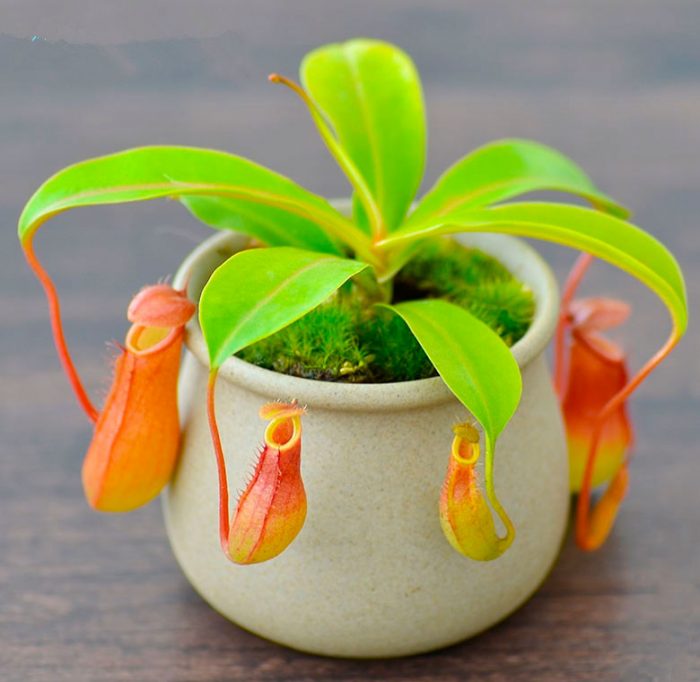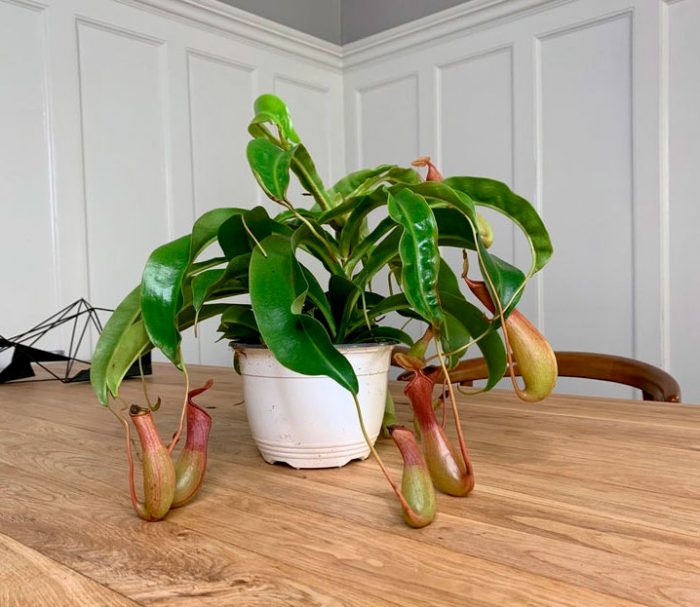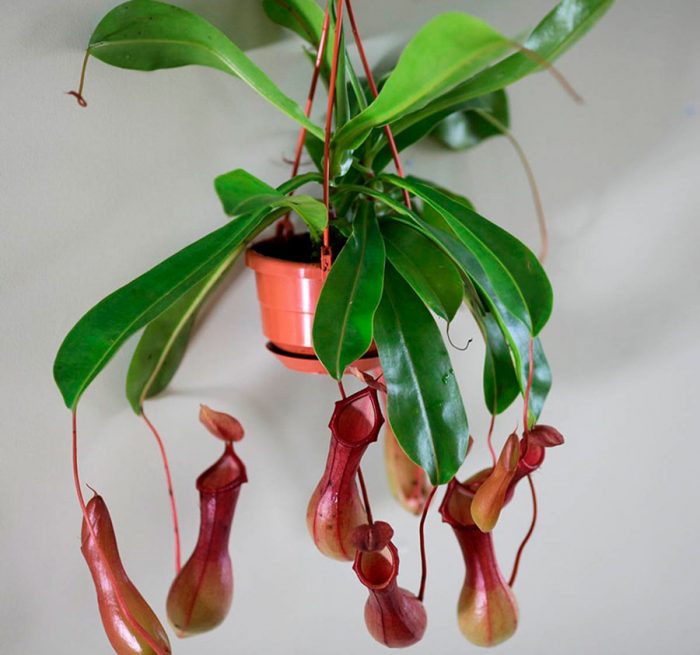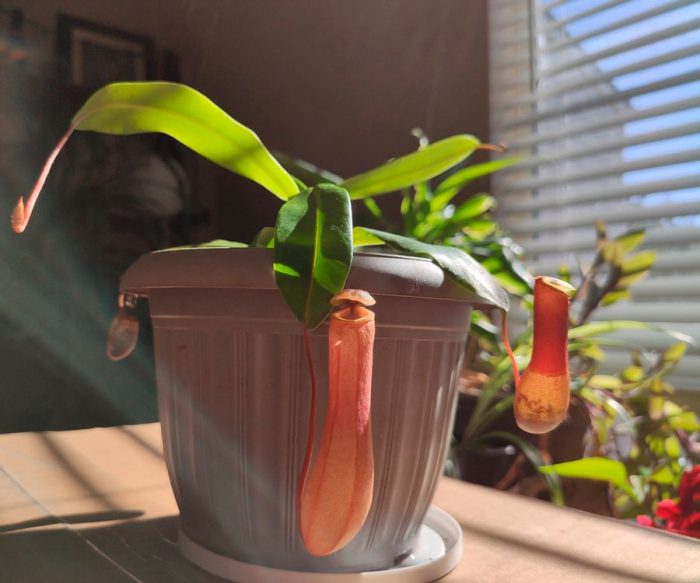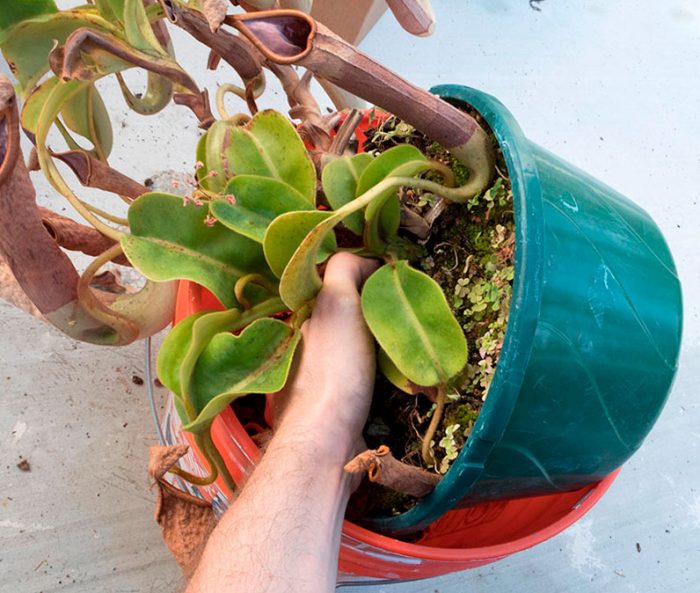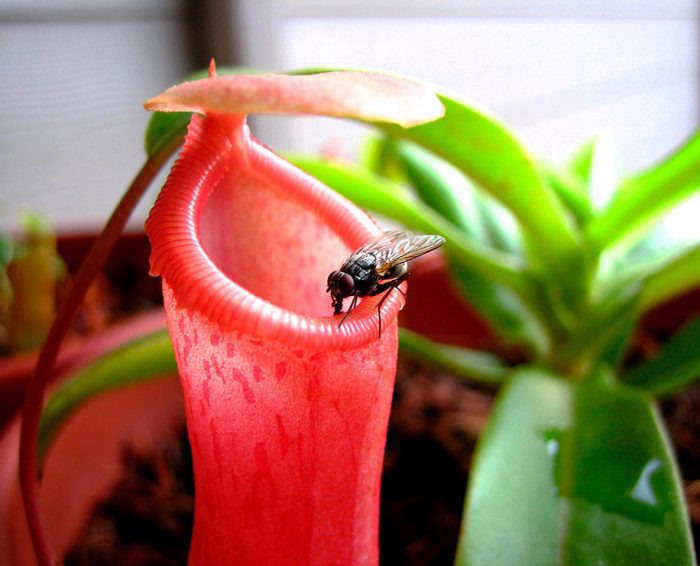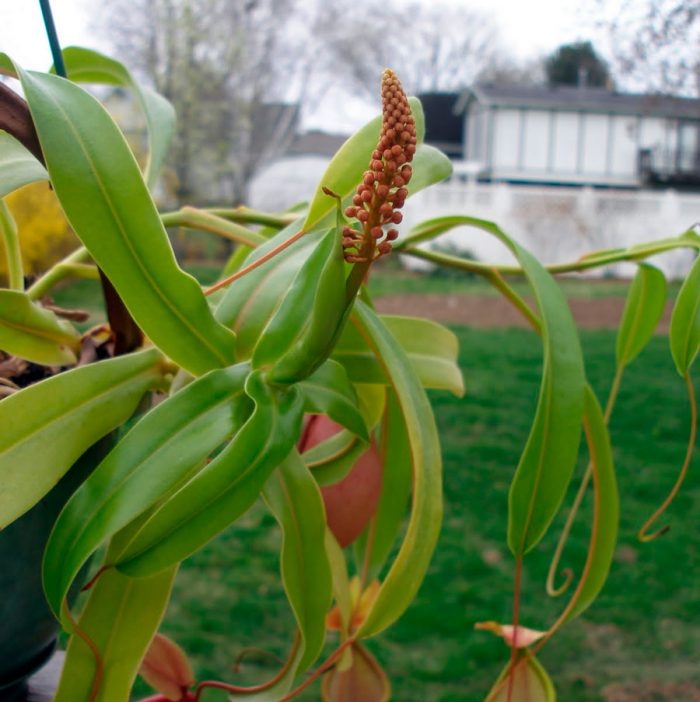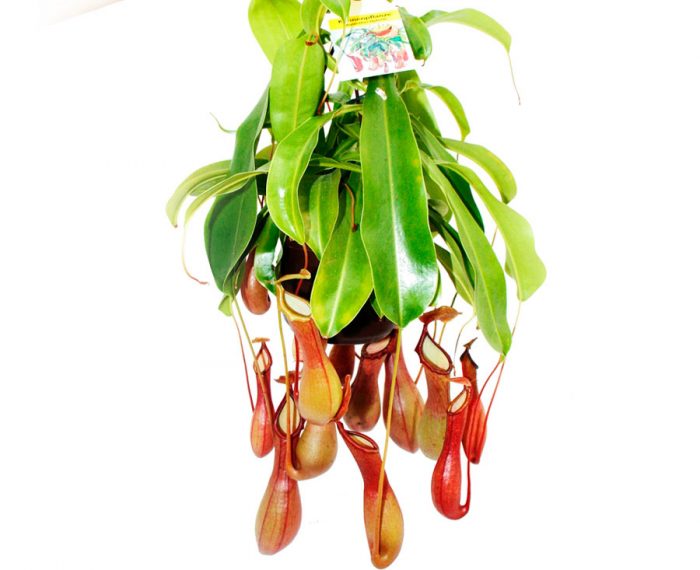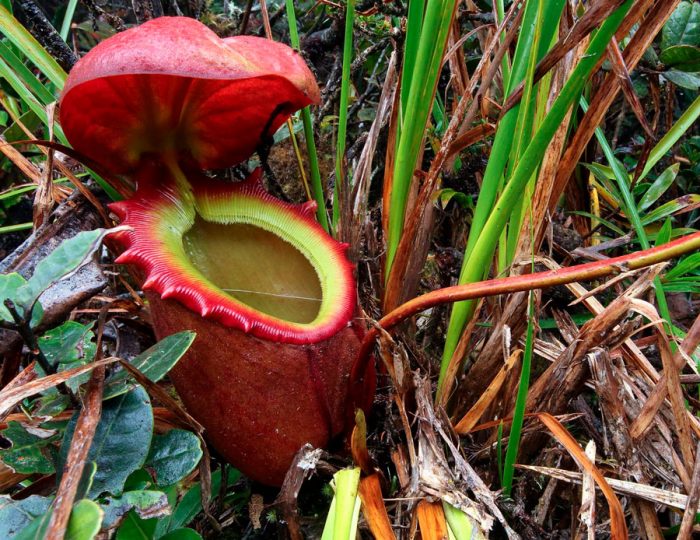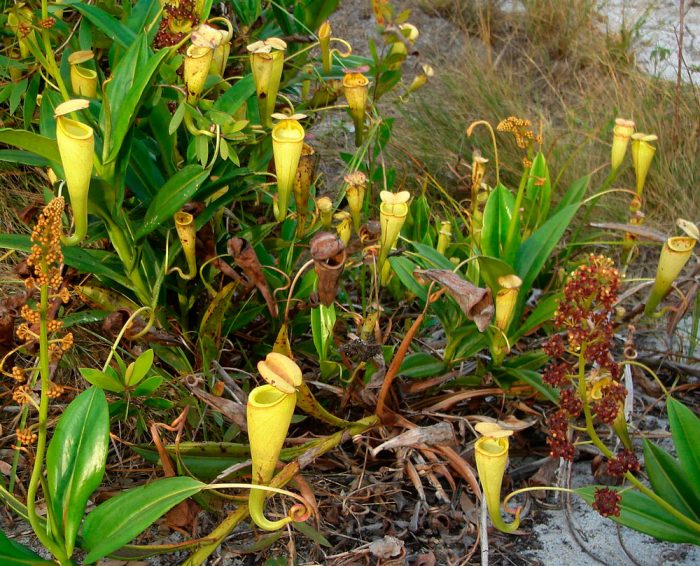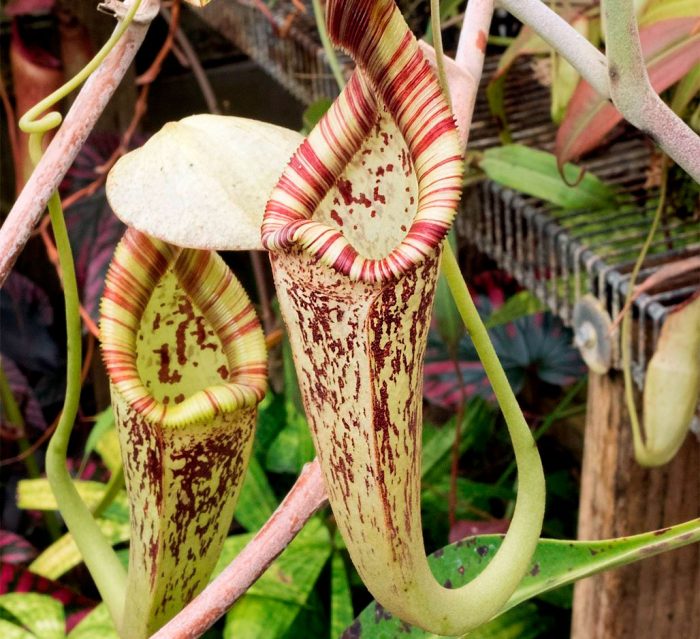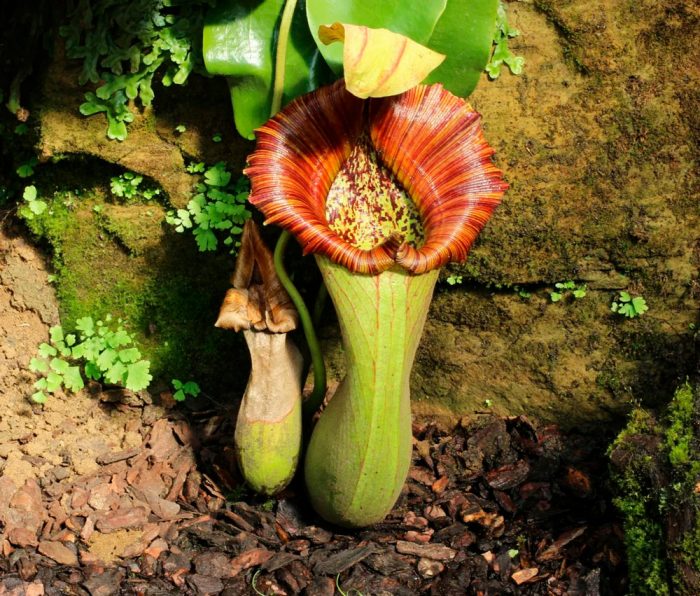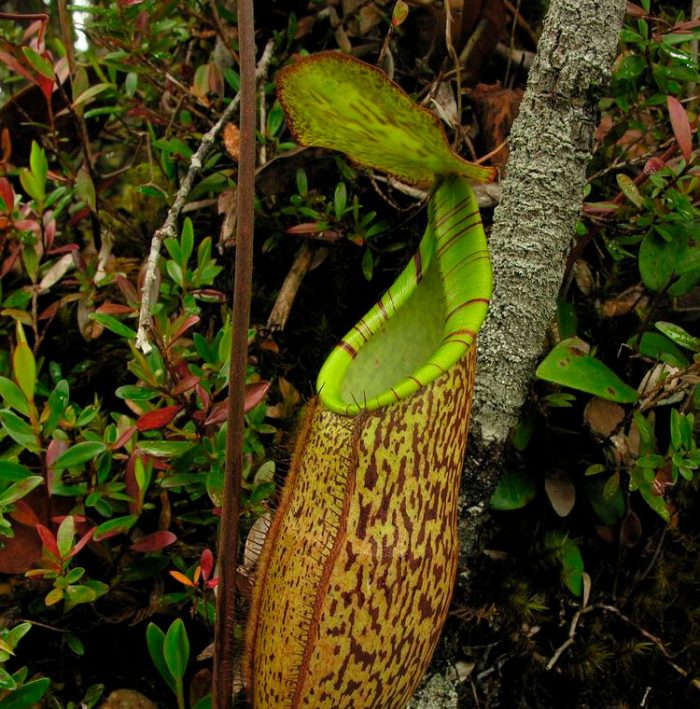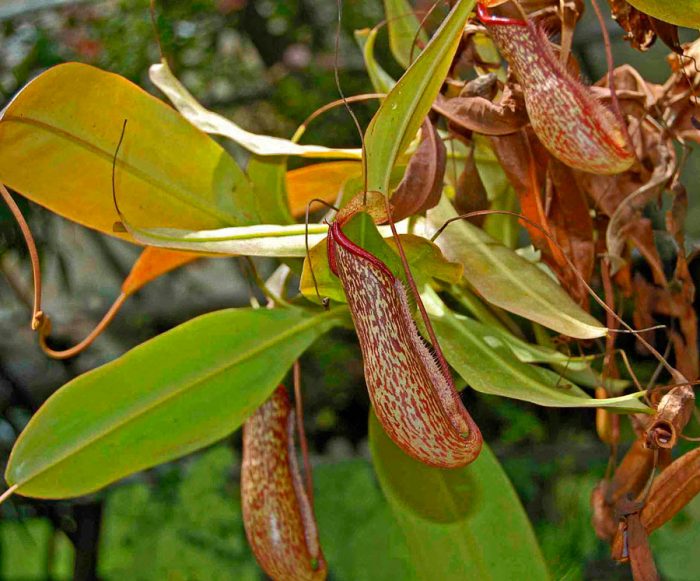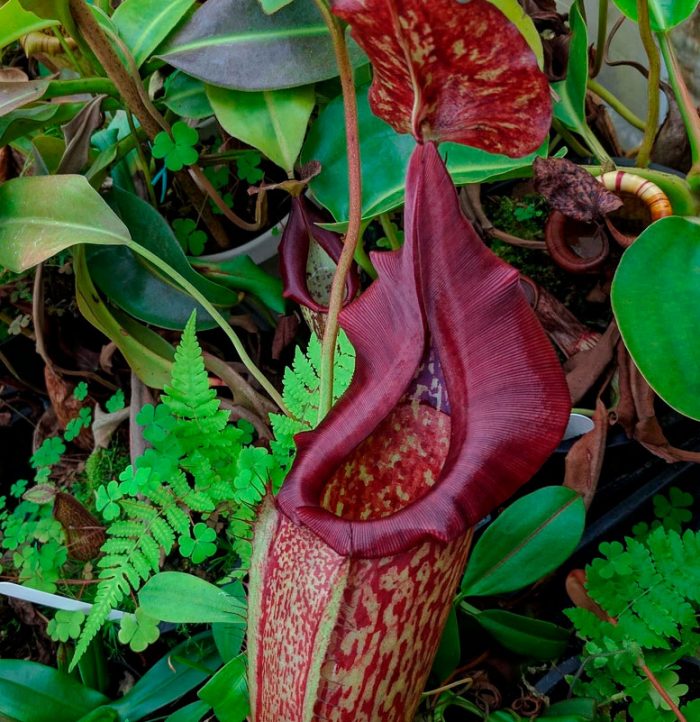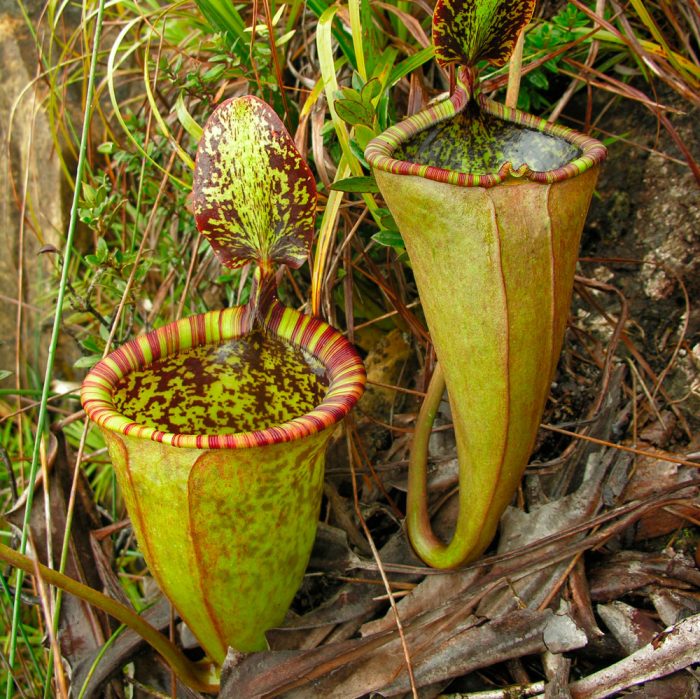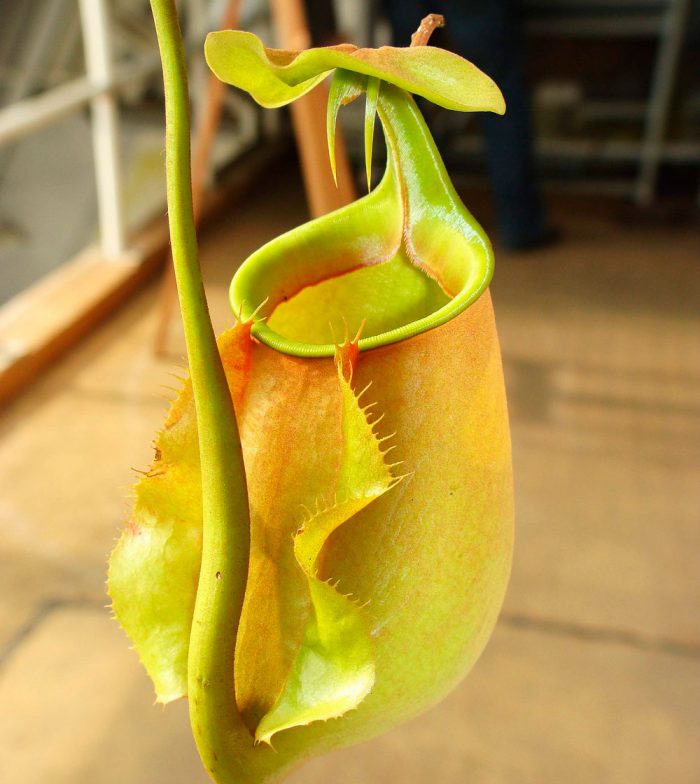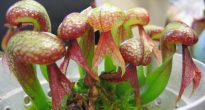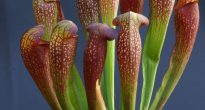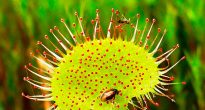The plant Nepenthes, which is also called the pitcher, is the only genus of the monotypic Nepenthes family. The name of this unusual plant was derived from the word "nepenthus", as the herb of oblivion was called in ancient Greek mythology.
In natural conditions, nepentes is most widely distributed in the tropical part of Asia, more precisely, on the island of Kalimantan. The eastern border of the range of this plant reaches New Guinea, New Caledonia and Northern Australia, and the western border - to the Seychelles and Madagascar. Nepentes is a carnivorous plant that "eats" various insects. He has strong symbiotic bonds with some of the animals. For example, mountain tupai use large species of such a plant as dry closets: this small animal leaves its droppings in jugs while eating nepenthes nectar. This dung is used by the flower as fertilizer. Jugs are used by bats as a place to sleep, there they are not bothered by annoying insects, and there is no need to fight for such a sleeping place with their relatives. For this plant receives the nitrogen it needs from the excrement left by the mice.
Content
Brief description of cultivation
- Bloom... It is observed in the spring-summer period and lasts 3–7 months.
- Illumination... The light should be bright, but diffused. A window facing south or east is best suited, but the bush must be protected from the scorching midday rays of the sun. If he stands on the north window, then in winter he will need illumination for 16 hours.
- Temperature regime... Mountain species grow well and develop at an air temperature of 18 to 20 degrees in summer and spring, and at 12-15 degrees in winter. Plain species in winter should be cool (from 16 to 20 degrees), and during the spring-summer period at a temperature of 22-26 degrees.
- Watering... The potted soil is moistened systematically, and bottom watering (through drainage holes) is best for this plant. During the spring and summer period, make sure that the potting soil is constantly slightly damp. In the cold season, watering is carried out only when the soil mixture dries out to a depth of about 0.5 cm.
- Humidity... Some types of nepentes need high air humidity: within 70-90 percent. At the same time, other species feel quite comfortable with a humidity of about 40% - during the day, and at least 50% - at night. Every day, moisten the foliage with a spray bottle, and add wet expanded clay or peat to the pan.
- Fertilizer... This carnivorous plant does not need feeding, as it receives nutrients from the insects it eats. Once every 4 weeks, a live insect (fly, spider or bloodworm) should be placed in the jug. In this case, the insect must be put in a different jug each time.
- Dormant period... Not pronounced. However, during the heating season, the jugs dry out. With the onset of the spring period, it is necessary to cut off all the foliage almost to the base, after which it will be necessary to restore the irrigation regime, and also top dressing with a solution of a mineral complex of weak concentration.
- Transfer... It is held in the spring and only when necessary.
- Reproduction... By dividing the bush, cuttings and seeds.
- Pests... Mealybugs and aphids.
- Diseases... Fungal rot.
Features of nepentes
Nepentes is an insectivorous plant, which is represented by a shrub or semi-shrub mixotrophic vine. Its long herbaceous shoots can freely climb tree trunks and branches quite high. They do this in order to find sunlight for the apical narrow inflorescences, which have a racemose or paniculate shape. Large alternately arranged leaf plates have a drawn-out tip and a convex central vein. In addition to simple leaf plates, jug-like ones are formed on the shoots. The petioles of such foliage in the lower part are wide and flat, then they are transformed into a thin tendril that wraps around the branch. At the tip of this antenna, a jug is formed that looks similar to an unusual flower. Depending on the type of nepentes, its jugs can differ in shape, size and color. Their length varies from 2.5 to 30 centimeters. However, there are specimens with half-meter long jugs. Their color can be rich dull white, spotted, greenish or red with a crimson speck. The upper edge of the jug, curved inward, is decorated with grooves of pink or lilac.
On the inner edge of the jug, there are special cells necessary for the production of sweet nectar. Inside the jug is water or a digestive fluid containing the enzyme nepentesine. To prevent debris from getting inside, the neck of the trap is covered with a kind of lid. The smell of nectar attracts insects, which, after getting under the lid, slide inside the jug and end up in the digestive fluid. To digest an insect, the plant needs 5–8 hours. As a result, only the chitinous membrane remains of it. However, not only insects can fall into such a trap, but also small amphibians, birds or rodents.
During flowering, petal dioecious flowers with low decorative effect open on the plant. Their sepals are tiled. After pollination, the fruit is formed, which is a leathery capsule, which is divided into chambers by partitions. Small seeds are located in each of the chambers.
At home, nepentes is rarely grown, since any of the species of this plant will not be able to fit in a small greenhouse. And growing it on a window is quite difficult, since it needs high humidity.Greenhouses are ideal for growing such a predatory plant, while small species can be kept in a "closed tropical window".
Caring for nepentes at home
Lighting
Nepentes, growing indoors, needs a lot of bright light, which must be diffused. In this regard, a window of an east or south orientation is best suited for it, while the bush must be shaded from the scorching rays of the sun at noon, for this you can use paper or translucent fabric. If the bush is placed on a window located in the western or northern part of the building, then it will need mandatory lighting. In winter, the plant must be illuminated throughout the day for 16 hours.
Temperature regime
Experts divide all types of nepentes into 2 groups according to the requirement for the temperature regime:
- Mountain views... In the cold season, they are moved to a cool place (from 12 to 15 degrees). In the spring-summer period, they also do not need heat, the optimum air temperature at this time is 18-20 degrees. If there is an excessively high temperature in the room for a long time, then this can cause the development of the disease.
- Plain views... The air temperature in summer is 22-26 degrees, and in winter - 16-20 degrees. If the room is colder, this can cause the death of the predatory flower.
Do not forget to systematically ventilate the room, preventing air stagnation in it. At the same time, protect the plant from drafts and move it only when absolutely necessary, and also do not turn the pot around its axis. If you disturb a flower, this can lead to the fact that it will suspend its growth and development for 1-1.5 months, and also during this time it will not form jugs.
Garter
This plant needs support. Its first garter is carried out after the stem reaches a length of about 50 cm. It is recommended to install the support during the transplantation of a bush that is 1 year old.
Watering nepentes
When growing indoor nepentes, special attention should be paid to watering. They must be systematic. Distilled water is best suited for irrigation, but as a last resort, you can use well-settled water, passed through a filter or rainwater. Whichever water you choose, its temperature should be room temperature or slightly warmer.
Bottom watering is ideal for this exotic predator. Do not forget to drain the excess water from the pot after the procedure. During the warm season, make sure that the substrate in the container is constantly slightly damp. In winter, the bush is watered only 2 days after the surface of the soil mixture dries out to a depth of 0.5 cm. If the liana is provided with a cool wintering, then the bush should be watered moderately and not very abundantly.


Watch this video on YouTube
Air humidity
Most types of nepentes need high air humidity, which should be 70–90 percent. But at home, such species are also cultivated that do not require high humidity: in the daytime they can quite normally exist at 40%, and in the dark at 50%.
Experienced florists recommend first observing the newly acquired nepentes bush, as it is quite possible that it will be able to adapt to the level of humidity that is typical for your home. But this does not always happen, so the bush will have to be moistened every day from a spray bottle, using well-settled non-cold water for this. It is also recommended to pour expanded clay or peat into the pan of the pot and pour some water.
Nepentes transplant
Transplanting such a plant is carried out only when necessary.For example, if the root system becomes very cramped in the pot or mold forms on the soil mixture. For planting nepentes, a planter or a hanging basket for orchids, as well as an ordinary flower pot, are suitable. But keep in mind that the capacity should be at least 14 centimeters across.
As a substrate, you can use a commercially available soil mixture for orchids. You can cook it yourself. To do this, combine vermiculite, perlite and high peat in a ratio of 1: 2: 2. There is another composition: peat, leafy soil and sand (2: 3: 1), and also add a small amount of charcoal. Remember that the substrate should never be acidic.
The flower is transplanted in the spring. If it is healthy, then it is enough just to carefully transfer it into a new container, while trying not to injure the root system. However, if there is a suspicion that the bush is sick, then it is taken out of the pot, the entire soil mixture is carefully removed from the roots, after which they are washed with distillate. Then the transplant is carried out as usual. Water the transplanted bush and treat it with Topaz or Fundazol solution, and it should get both on the foliage and on the surface of the soil mixture. If the vine successfully takes root after transplantation, then after 15 days it is moistened with a Zircon solution from a sprayer (2-3 drops per 200 ml of distilled water). The substrate is spilled with the same solution.
If everything is done correctly, then the bush will not need transplants for 3-5 years. And in the event that nepentes is planted in mineral wool, volcanic stone, coconut shells or in another material that decomposes very slowly, then you will have to replant the flower again no earlier than 10 years later.
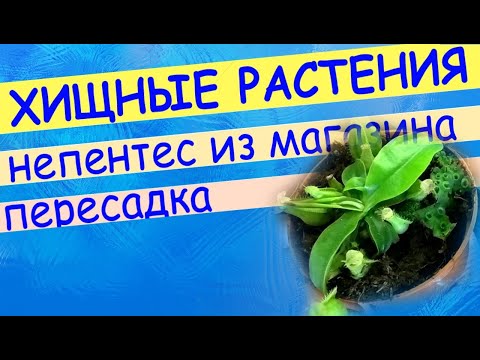

Watch this video on YouTube
Top dressing
There is no need to feed the bush in the usual way, since it gets its own nutrients from the insects it eats. However, it will not hurt him if in the summer 1 time in 4 weeks it is fed with a solution of mineral complex fertilizer, the concentration of which should be 3 times weaker than that recommended by the manufacturer on the package. Remember that overfed nepentes stops forming jugs.
It is necessary to feed the indoor nepentes regularly once every 30 days. To do this, one living insect is thrown into half of the jugs, for example, you can take a spider, bloodworm, or an ordinary fly. It is impossible to throw "food" into all the jugs, because a large amount of nitrogen can lead to the death of the vine. The use of dead insects is also prohibited. Remember that the digestive secretion is formed only once in each jug. In this regard, if the jug became empty, then it will no longer be able to digest the prey. Remember that you cannot throw "food" into such a jug, as this can only lead to the death of the leaf. In order for an empty jug not to die very quickly, it needs to be filled 1/3 with distilled water.


Watch this video on YouTube
Bloom
During flowering, erect inflorescences are formed, which consist of regular brownish-red flowers. Flowering can last up to 6 months. The flowers are not highly decorative, but they attract attention by the fact that they are very unusual.
Wintering
As such, the nepentes does not have a rest period. However, mid-latitude winters are not like tropical winters, so you need to know how to care for the plant during this period.
In late autumn, any feeding of the predatory liana is stopped, and they also begin to water it less often. Pitchers may begin to dry up near the bush, but you should not be afraid, as this is due to the excessively low humidity in the room in winter.
With the onset of spring, all leaf plates should be cut off almost to the base. Water the bush as usual in the summer, and add a mild fertilizer solution to the soil.If everything is done correctly, then the bush will definitely begin to grow actively.
Reproduction methods
Growing from seeds
Growing indoor nepentes from seeds is not difficult. However, it is almost impossible to get quality seed material. And buying from an unverified seller is also dangerous, as you can spend a lot of money on seeds of a perfect other plant.
And the difficulty of growing nepentes from seeds is that they lose their germination rather quickly (after 15–20 days). However, if the seeds are of high quality and fresh, then your chances of growing nepentes will increase dramatically.
Take a small plastic container with drainage holes and fill it with moistened sphagnum moss, which should be rinsed thoroughly and microwaved for 2 to 3 minutes to disinfect. Take the seed and spread it evenly over the moss surface. Water the crops with a fine spray, after which they are placed in a plastic box and covered with a transparent lid on top. This will help maintain the required high humidity.
Remove crops in a mini-greenhouse, which is placed under phyto-lamps. Arrange daily ventilation for crops, and do not forget to regularly measure the humidity and air temperature, which should be at 90-100 percent and 20 degrees, respectively. After the seedlings appear, they need to be provided with the same care as for the seedlings of other exotic plants. However, it is necessary to adapt the seedlings to the conditions of your apartment for several weeks.
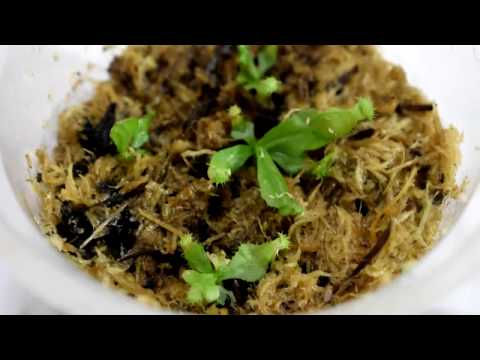

Watch this video on YouTube
Cuttings
It is much faster and easier to propagate such an unusual plant by cuttings. For example, for rooting, you can use the pieces left after spring pruning. Ideally, there should be 3 leaf plates on the handle. Shorten them by two-thirds. At the apical cutting, the small upper leaf plate does not need to be removed.
The lower part of the cuttings is kept in Kornevin's solution for half an hour, after which the places of the cut are covered with coal, crushed to a powdery state. Take a small container, which should be thoroughly rinsed with bleach, then rinsed with distillate. Also, for planting cuttings for rooting, you will need a special soil mixture consisting of 2 parts of sphagnum, 3 parts of coconut fiber and 5 parts of peat, and a little vermiculite is also added to it. Disinfect the resulting mixture, moistened with distilled water, in a microwave oven for a quarter of an hour.
Dip the lower part of the cutting into the substrate by at least 0.5 cm. After that, gently slightly compact the soil mixture around it and water with distillate. The cutting itself is treated from a spray bottle with a Fundazole solution. Then the container with the handle is covered with a transparent cap (transparent bag, glass jar, etc.). After that, she is placed in a well-lit and warm (about 23 degrees) place. After a couple of weeks, spill the soil mixture and treat the stalk from a spray bottle with a solution of Zircon (2 or 3 drops of the product for 200 milligrams of distilled water).
Cuttings take root for 4-6 weeks. However, after a couple of weeks it is already possible to evaluate the result: if the cuttings have given roots, then they will have new shoots with jugs, and if the segments have darkened, then they can be thrown out. Only 1 year after rooting, you can carefully transplant the flower into a permanent pot using the transshipment method.
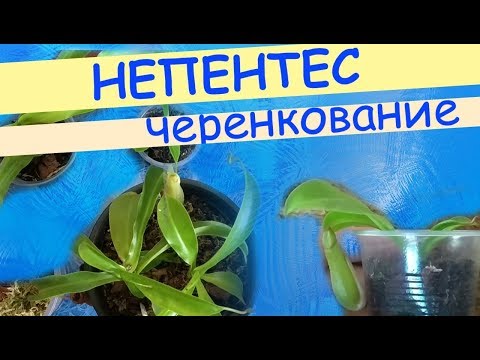

Watch this video on YouTube
Dividing the bush
For reproduction of nepentes, the method of dividing the bush during transplantation is also used. But be extremely careful, because the root system can be severely injured, as it is very fragile and delicate. It is necessary to divide the bush of this liana in the same way as with other plants.
Diseases and pests of nepentes
Diseases of nepentes
In some cases, red or brown specks may appear on the foliage of homemade nepentes. This suggests that he is affected by a fungal disease, the development of which is provoked by the high humidity of the air and soil mixture. To cure the affected bush, it is treated with a fungicide solution.
Due to excessive watering, rot may appear on the root system. In a diseased plant, the foliage shrinks and loses its turgor, and the stem is also blackened. Also, due to excessive moisture, foliage can also rot. As soon as signs of rotting are noticed, transplant the flower into a fresh disinfected substrate, while all the affected areas are cut out from it with a sterilized sharp instrument, and the places of the cuts are sprinkled with powdered charcoal. If the bush nevertheless begins to die, then cut off healthy cuttings and plant them for rooting.
If the foliage turns yellow, this means that the vine needs feeding. When sunburn appears on the leaf plates, they change their color to red. If nepentes suffers from excessively bright lighting, then brown spots with necrotic areas form on its foliage. And in the case when the bush does not have enough light, it becomes very elongated, and there is also a slowdown in its development, shrinking foliage, and the cessation of the formation of jugs.
Pests
Despite the fact that this plant is insectivorous, mealybugs and aphids can harm it.
Worms feed on plant sap, sucking it out of young foliage and shoots. Because of this, they begin to grow more slowly. In order to prevent the appearance of this pest, the bush should be moistened and washed in a timely manner, and also do not forget to cut off the dried leaves. If worms appear, remove them with a cotton swab or swab moistened with a solution of soap, beer or alcohol. Then the bush should be sprayed with a solution of an imidacloprid-based product for 1.5 months at a frequency of 1 time in 1-1.5 weeks.
While there are few aphids on the bush, it is difficult to find them. It is located on the seamy surface of the foliage, due to which it becomes covered with dew and turns yellow. In addition, this insect is the main carrier of incurable bacterial and viral diseases. To get rid of pests without harming nepentes, it must be washed with a solution of potassium soap (20 g per 1 liter of water). Make sure that soapy water does not get into the soil mixture. You can replace green soap with regular household soap or dishwashing detergent. You can also treat the bush with low-toxic agents, such as: Biotlin, Decis, Antitlin or Karate.
Types of nepentes with photos and names
In natural conditions, there are 7 types of nepentes. But thanks to the efforts of breeders, 247 hybrids of this plant were born. Below will be described those types and hybrids of nepentes that are popular with flower growers.
Nepenthes alata, or winged nepentes
The homeland of such a plant is the Philippines. Under natural conditions, its length can vary from 1.5 to 4 meters. Green leaves with a pointed tip at the top have a lanceolate or oblong shape. The jugs of bright light green color are decorated with red dots. During flowering, flowers are formed, collected in brushes or panicles.
Nepenthes Rajah
This is the rarest and largest liana, which in nature can reach a length of about 600 cm. The length of the jugs is about 35 centimeters, while they reach 16 centimeters in diameter. This species uses both insects and small vertebrates as food.
Nepenthes madagascariensis
The height of such a perennial plant is only about 0.6–0.9 m. Its foliage is oblong-lanceolate, while the winged crimson jugs reach about 25 centimeters in length.
Nepenthes rafflesiana
This species is a Sumatran epiphytic plant.Its lanceolate-oval foliage reaches about 10 centimeters in diameter and about half a meter in length. On the surface of the greenish jugs there are spots and stripes of a red hue. Their diameter is 7–10 centimeters, and their length is 10–20 centimeters. The pale blue inner surface of the jug is covered with red specks.
Nepenthes truncata
This plant is endemic to the Philippine island of Mindanao. It is found in mountainous areas at an altitude of 230–600 m above sea level. Some of the varieties are found at higher altitudes. The length of one jug can be up to half a meter. In this regard, the species is usually used for growing in greenhouses.
Nepenthes gracillima
Under natural conditions, this plant is about 5 meters long. Its leaf plates are narrow and long. The cylindrical jugs are painted green and decorated with dark green and red dots.
Nepenthes Miranda
This species is a semi-epiphytic plant. Large jugs have a pungent green hue with deep red dots on their surface.
Nepenthes maxima
The length of such a plant is about 300 cm. Its narrow leaf plates in length reach about 30 centimeters. The length of the upper cylindrical jugs is about 30 centimeters, while the lower ones are shorter and have a bulbous shape. The greenish-yellow jugs are decorated with red-colored warty projections.
Nepenthes attenboroughii
In nature, the species can only be found on the Philippine island of Palawan. The height of such a shrub is about one and a half meters, while its branches reach about 35 mm in diameter. Almost sessile leaf plates are leathery to the touch. The volume of the jugs is about one and a half liters, their diameter is about 12 centimeters, and their length is up to 25 centimeters. They are painted in a rich green shade, and they are decorated with strokes of purple.
Nepenthes bicalcarata
This type is one of the largest and most decorative. The shape of its petiole leaf plates is obovate-lanceolate, leathery to the touch. The diameter of the leaves is about 12 centimeters, and the length is up to 0.8 m. The jugs can be colored orange, green or red.
In addition to these species and hybrids, such as hairy nepentes, Pervilla, white-bordered, pitched, wall-leaved, etc. are quite popular in room culture.
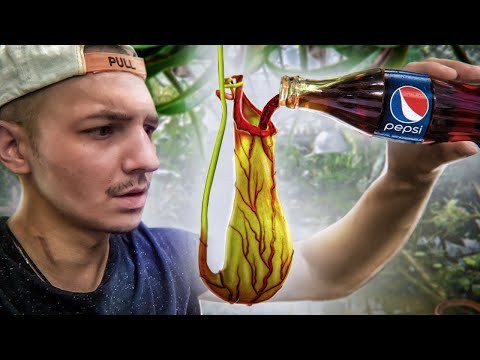

Watch this video on YouTube



